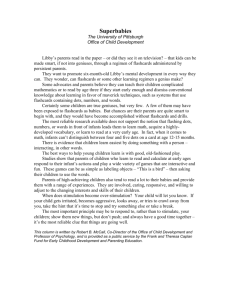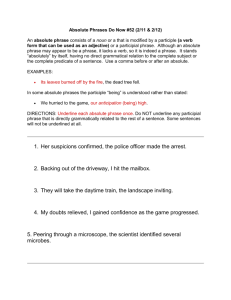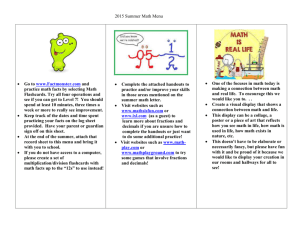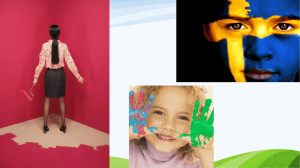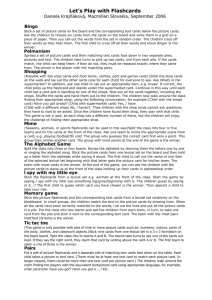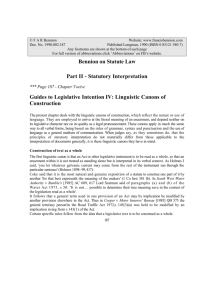From Springboard Level 1 Visualizing Vocabulary Page 259 (adapted)
advertisement
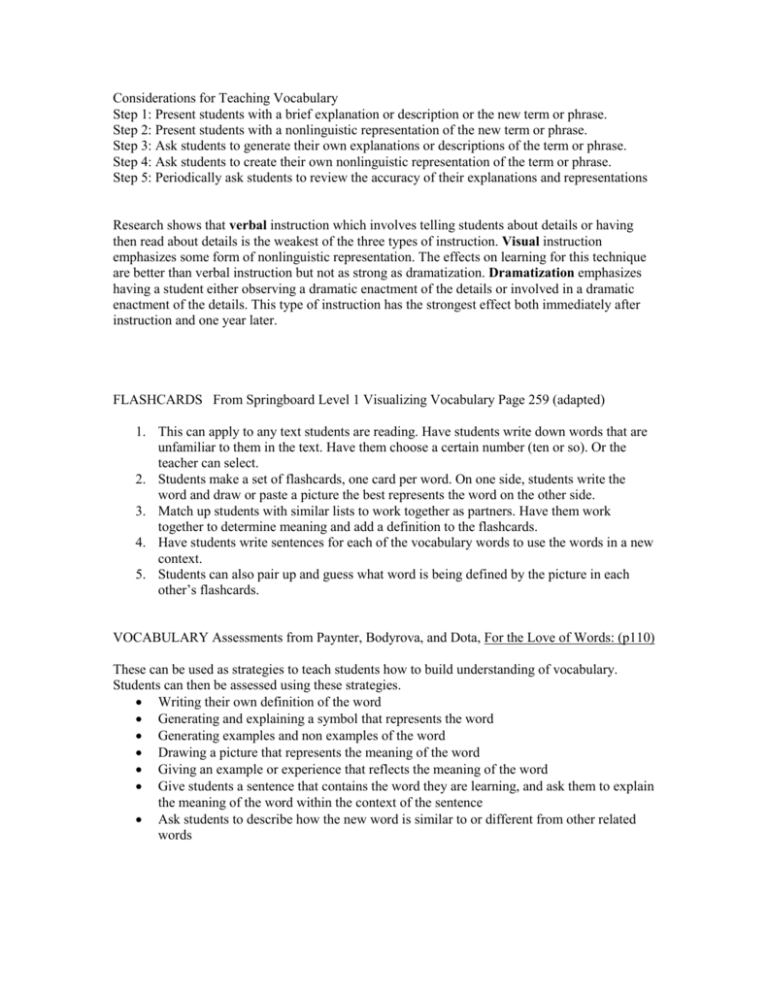
Considerations for Teaching Vocabulary Step 1: Present students with a brief explanation or description or the new term or phrase. Step 2: Present students with a nonlinguistic representation of the new term or phrase. Step 3: Ask students to generate their own explanations or descriptions of the term or phrase. Step 4: Ask students to create their own nonlinguistic representation of the term or phrase. Step 5: Periodically ask students to review the accuracy of their explanations and representations Research shows that verbal instruction which involves telling students about details or having then read about details is the weakest of the three types of instruction. Visual instruction emphasizes some form of nonlinguistic representation. The effects on learning for this technique are better than verbal instruction but not as strong as dramatization. Dramatization emphasizes having a student either observing a dramatic enactment of the details or involved in a dramatic enactment of the details. This type of instruction has the strongest effect both immediately after instruction and one year later. FLASHCARDS From Springboard Level 1 Visualizing Vocabulary Page 259 (adapted) 1. This can apply to any text students are reading. Have students write down words that are unfamiliar to them in the text. Have them choose a certain number (ten or so). Or the teacher can select. 2. Students make a set of flashcards, one card per word. On one side, students write the word and draw or paste a picture the best represents the word on the other side. 3. Match up students with similar lists to work together as partners. Have them work together to determine meaning and add a definition to the flashcards. 4. Have students write sentences for each of the vocabulary words to use the words in a new context. 5. Students can also pair up and guess what word is being defined by the picture in each other’s flashcards. VOCABULARY Assessments from Paynter, Bodyrova, and Dota, For the Love of Words: (p110) These can be used as strategies to teach students how to build understanding of vocabulary. Students can then be assessed using these strategies. Writing their own definition of the word Generating and explaining a symbol that represents the word Generating examples and non examples of the word Drawing a picture that represents the meaning of the word Giving an example or experience that reflects the meaning of the word Give students a sentence that contains the word they are learning, and ask them to explain the meaning of the word within the context of the sentence Ask students to describe how the new word is similar to or different from other related words Strategy: Creating Analogies 1. Identify how the two elements in the first pair of words are related 2. State the relationship in a general way 3. Identify another pair of elements that share a similar relationship A is to B as C is to D. Feather is to bird as leaf is to tree Strategy: Creating metaphors 1. Identify the attributes or characteristics of the first word in the metaphor 2. Identify the attributes or characteristics of the second word in the metaphor 3. Look at the characteristics or attributes for both words of the metaphor and try to find attributes that are somewhat related. State the relationship of these attributes in a very general way by: Placing words for specific things with words for more general things Summarizing information whenever possible A political map is a puzzle Nutrients are the building blocks of our body Strategy: Completing a semantic feature analysis: Students are given a matrix that contains key vocabulary words that are semantically related ( ex. A worksheet with the broad category of transportation with the various forms such as bike, car, plane, river, stroller. Categories to consider would be; takes you places, man-made, does not move by itself, uses fuel, etc.) Students then think about the word and determine whether to place an X in the box for each characteristic or feature for each term or phrase. Strategy: Classifying vocabulary Asking students to create categories or classify words helps them think of the distinctions among words that might be similar in meaning. Moving them beyond the obvious helps them see finer distinctions while deepening their understanding of the words they are classifying. Students can create their own categories. Word Game: Vocabulary Bingo Student generated definitions and/or symbols or illustrations are recorded on a set of cards. These are used to play bingo Word Cards: Students create word cards with the following information: Word Definition Sentence Personal clue Picture Activities: 1. Sort the cards by category. (e.g., words related to people, words related to things) 2. Find words that have certain connotations such as positive and negative, good and bad, concrete and abstract. 3. Sort words by parts of speech (e.g. nouns, verbs adverbs, and adjectives). 4. Make sentences using pairs of words. 5. Group words and then explain basis of groupings. Word Theater Acting out a word helps students live the word and remember it. Choose key words from a story and write them on a piece of paper. Put them in a container and have a student or groups of students pick one to act out or pantomime for the class. Riddle or a poem Students create a poem or a riddle using their definitions and then act it out. Other students guess the word for a preset list. Mnemonics to Remember One kind of mnemonic device is a sentence in which each word begins with a letter in the target vocabulary word for example- for BECAUSE Big Elephants Can Always Use Some Energy. Interviews: Students work with partners to ask twenty questions about a word to try to guess the word from a preset list. Graphic representation of the word; Students pick an object of a symbol that represents that word and illustrate the word using that symbol. For example students draw the word mountain with little drawings of mountains. Jeopardy First identify several new words that students are learning and write these on the board. Give the definition. Students answer in the form of a question and explain how they arrived at their answer. Teacher: the definition of this word is “below the skin.” Student: is the word subcutaneous? Teacher: Yes. How did you know that? Student: I know that sub in submarine means under and submarine goes under water. Additional Resources: Bromley, Karen. Stretching Students’ Vocabulary. Marzano, Pickering, Pollock, Classroom Instruction that works. Robb, Laura. Easy Mini-Lessons for Building Vocabulary.

